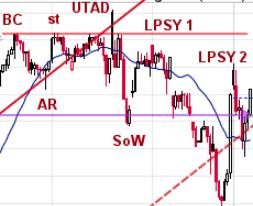Wyckoff at Work in the Intraday Timeframe
Understanding the principles of the Wyckoff method is essential for traders aiming to navigate the intricacies of the financial markets effectively. Though first introduced by Richard Wyckoff in the early 20th century, this methodology remains significant in modern trading practices. With a focus on interpreting price movements, volume, and market participants’ behavior, the Wyckoff method lends itself well to intraday trading strategies.
One key aspect of the Wyckoff method is the concept of accumulation and distribution. In the intraday timeframe, identifying these phases can provide valuable insights for traders. During the accumulation phase, prices consolidate as smart money accumulates shares at lower prices. This period is characterized by sideways movement and decreasing volatility. Traders can look for signs of increased volume and price holding at support levels to confirm the accumulation phase.
Once accumulation is complete, the distribution phase begins. This stage sees smart money distributing their accumulated shares to less informed market participants at higher prices. Intraday traders can spot distribution through price surges accompanied by high volume, as well as unsuccessful attempts to break resistance levels. Recognizing these signs can help traders avoid entering long positions near the end of a distribution phase.
The Wyckoff method also emphasizes the importance of volume analysis. In the intraday timeframe, monitoring volume can provide crucial clues about market dynamics. An increase in volume during price advances suggests strength, while low volume on pullbacks may indicate weakness. Traders can use volume confirmation to validate their trading decisions and assess the sustainability of price movements.
Another key principle of the Wyckoff method relevant to intraday trading is the concept of supply and demand. By analyzing price action and volume together, traders can gauge the balance between supply (selling pressure) and demand (buying interest) in real-time. Understanding these dynamics allows traders to anticipate potential price reversals or continuations, enhancing their decision-making process.
Moreover, the Wyckoff method encourages traders to pay attention to market sentiment and the behavior of various market participants. By observing how price reacts to news events, economic data releases, or key technical levels, intraday traders can gain insights into the underlying market sentiment. This nuanced understanding can help traders navigate volatile intraday price movements with more confidence.
In conclusion, the Wyckoff method offers a comprehensive framework for analyzing price movements, volume, and market dynamics in the intraday timeframe. By applying key principles such as accumulation and distribution, volume analysis, supply and demand, and market sentiment, traders can sharpen their intraday trading strategies and make informed decisions. Incorporating these Wyckoff principles into their trading approach can empower intraday traders to navigate the fast-paced and dynamic nature of the financial markets effectively.
